A History of Comets - Part 2
Testing gravity: How comets helped to prove Newton right
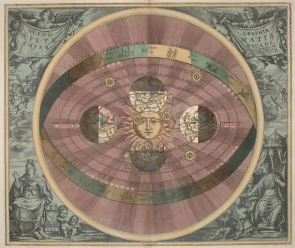 |
| The Copernican system, by Andreas Cellarius. In public domain, via Wikimedia Commons |
The idea of a heliocentric system, proposed in 1543 by Polish astronomer Nicolaus Copernicus, was supported by the studies and observations of Italian astronomer Galileo Galilei, who first introduced the telescope to the practice of astronomy in 1609, and German astronomer Johannes Kepler, who formulated the laws of planetary motion between 1609 and 1619.
This model firmly dismissed many older notions about the heavens; at the same time, the idea of comets being optical phenomena in Earth's atmosphere was also abandoned. Although comets had always been viewed as unwelcome omens connected to earthly events and catastrophes, firmly categorising them as celestial bodies unrelated to our planet weakened their reputation as portents of doom, slowly bringing them back into the realm of scientific investigation.
On open-ended orbits
Kepler observed several comets throughout his life, and tried to study their motion. However, he believed comets to be interstellar objects moving along straight lines, and so never fully grasped their dynamics. Some progress on understanding cometary orbits came from Polish astronomer Johannes Hevelius, who observed nine comets and described them in his Cometographia treatise, published in 1668.
Hevelius suggested that comets moved on open-ended parabolic orbits, meaning that they would be seen once and never again. This turned out to be partly true. Hevelius was on the right track, but a robust understanding of the orbital motion of comets would emerge only a couple of decades later, courtesy of English scientist Isaac Newton.
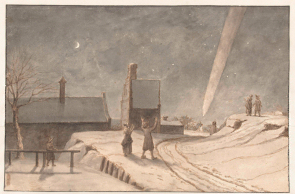 |
| The Great Comet of 1680 over the Dutch town of Alkmaar, in a painting by Lambert Doomer. Rijksmuseum, Amsterdam. In public domain |
Newton had been building on the work of Kepler and Galileo since the 1660s, finally announcing the results of his investigation into planetary orbits in 1687. In fact, it was thanks to the encouragement – and economic support – of a friend and colleague that Newton eventually published his Philosophiae Naturalis Principia Mathematica, the pioneering text in which he detailed a theory of universal gravitation. This friend of Newton's was Edmond Halley - an English astronomer whose name is indelibly linked to comets.
With his new theory at hand, Newton calculated the orbit of the Great Comet of 1680. His results were in excellent agreement with observations. Shortly after, Halley applied Newton's theory to the study of comets. This work would produce two major results: a striking confirmation of Newton's theory of universal gravitation, and a revolutionary change in our understanding of comets.
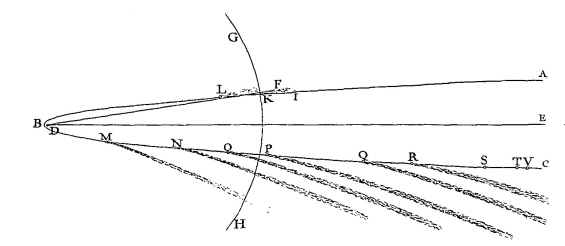 |
| The Great Comet of 1680, first comet orbit calculated using the theory of universal gravitation, by Sir Isaac Newton. In public domain, via Wikimedia Commons |
A predicted return
Halley decided to use Newton's theory to calculate the orbits for several comets – some of which he had observed during his lifetime, and many more that he had retrieved from ancient records. In the process he noticed something strange: some comets seemed to have remarkably similar orbits. He suspected that one comet in particular, which he saw in 1682, had already made an appearance once before, and was in fact the same one observed by Kepler in 1607 and by Apian in 1531.
With this, Halley was the first to suggest that comets may be periodic, moving along very elongated ellipses rather than parabolic paths. He went so far as to forecast the comet's return. With an estimated period of about 76 years, Halley expected the comet to be visible again between the years of 1758 and 1759. Halley died before he could view it with his own eyes, but others were able to test and confirm his conjecture and, with it, Newton's theory of gravity.
Interest in Halley's prediction spread to continental Europe. French mathematicians Alexis Clairaut, Joseph Lalande, and Nicole-Reine Lepaute spent several months performing detailed calculations on how the comet's path would be perturbed by various planets, working out its expected date of return and position in the sky. Astronomers across Europe began looking for it as early as 1757, avidly stargazing until the long-sought-after comet was finally spotted again on 25 December 1758 by Johannes Palitzsch, a farmer from Germany.
The sighting of this comet, which has since carried Halley's name, was a proof of Newton's theory of gravity, demonstrating that it can be applied not only to planets but to other celestial bodies too. It also marked one of the greatest triumphs of science: finally we understood how comets slotted into the cosmos, just as Seneca had hoped for many centuries earlier. Comets were no longer so unpredictable. As such, they started to be viewed as harmless, and slowly but surely popular prejudices and superstitions linked to comets began to fade away.
Impacting science
Although the nature of comets had been established, the investigation of these objects raised many new questions and opened up new disciplines of study.
One avenue of investigation was the role of comets in Earth's history. As increasing numbers of fossils were excavated from the depths of our planet, some scientists tried to explain their variety as having been caused by a series of short-lived, catastrophic events such as floods, volcanic eruptions, and cometary impacts. Others advocated a more uniform process, with gradual changes slowly taking place over millennia. Both interpretations eventually converged to form the currently dominating view of Earth's history as a slow, gradual process punctuated by occasional natural catastrophic events.
Another field of study had its origins in an astronomical catalogue compiled by French astronomer Charles Messier in the 18th century. While scanning the sky in search of comets – and discovering thirteen new ones – Messier made an inventory of over a hundred blurry objects that he dubbed "nebulae". Originally intended as an aid for comet hunters such as himself, Messier's catalogue later became a very valuable database for astronomers with diverse research interests – his nebulae turned out to be stellar clusters, star-forming clouds, remnants of exploding stars, and even galaxies beyond our own.
Although it seemed like our understanding of comets was becoming more complete, one vital piece was missing from this puzzle – we may have understood more about what comets are, but where do they come from? What prompts these celestial bodies to appear in our skies? These questions were to be answered in the coming centuries by astronomers who revealed much about not only comets, but also about the Solar System's place in our Galaxy.
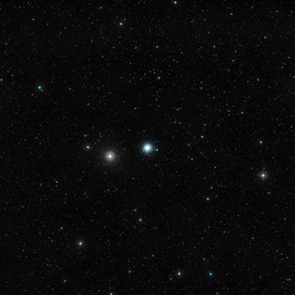 |
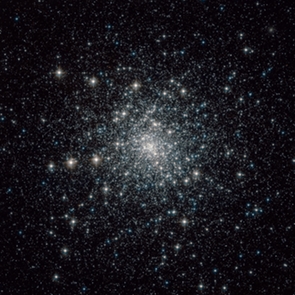 |
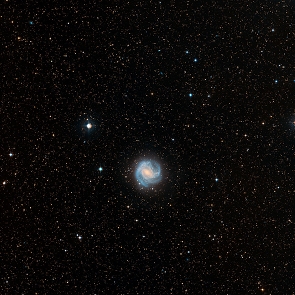 |
.jpg) |
|
Upper row: The globular cluster listed as M30 in Messier's catalogue, in a wide-field view from the Digitized Sky Survey (left) and as viewed in greater detail with the NASA/ESA Hubble Space Telescope (right). Lower row: The spiral galaxy listed as M83 in Messier's catalogue, in a wide-field view from the Digitized Sky Survey (left) and in a combined view from Hubble and the Giant Magellan Telescope (right). Credit: ESO and Digitized Sky Survey 2 (upper left); NASA/ESA (upper right); Digitized Sky Survey, STScI/AURA, Palomar/Caltech and UKSTU/AAO (lower left); NASA, ESA, and the Hubble Heritage Team (STScI/AURA) - Acknowledgment: W. Blair (STScI/JHU), Carnegie Institution of Washington (Las Campanas Observatory), and NOAO (lower right). |
|
| < |
A History of Comets - Part 1: Harbingers of doom, 'windy exhalations', or icy wanderers? |
A History of Comets - Part 3: On the origin of comets |
> | |
